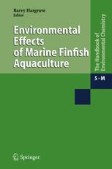Search
Search Results
-
Dissolved Oxygen and Salmon Cage Culture in the Southwestern New Brunswick Portion of the Bay of Fundy
Information on the spatial and temporal characteristics of ambient dissolved oxygen in the southwestern New Brunswick area of the Bay of Fundy is...
-
Assessing and Managing Environmental Risks Associated with Marine Finfish Aquaculture
Environmental Risk Analysis (ERA) consisting of risk assessment, management and communication can be applied to assess ecological and...
-
Synthetic Musks in the Aquatic System of Berlin as an Example for Urban Ecosystems
This chapter compiles some data on the occurrence and fate of synthetic musk compounds in the aquatic environment of Berlin, Germany. The city of...
-
Emissions of Volatile Organic Compounds from Products and Materials in Indoor Environments
Building products, furnishings and other indoor materials often emit volatile and semivolatile organic compounds (VOCs and SVOCs). With respect to a...
-
Modelling the Impacts of Finfish Aquaculture
The main components of lagrangian (particle tracking) models used in the assessment of aquaculture impact have been reviewed. Trends in input data...
-
Far-Field Impacts of Eutrophication on the Intertidal Zone in the Bay of Fundy, Canada with Emphasis on the Soft-Shell Clam, Mya arenaria
A study was conducted in the Bay of Fundy, Canada in 2000–2003 to examine the effects of Ulva-dominated algal mats on the population dynamics of...
-
A Review and Assessment of Environmental Risk of Chemicals Used for the Treatment of Sea Lice Infestations of Cultured Salmon
Chemicals (sea lice therapeutants) currently authorized in North America and Europe for the treatment of sea lice infestations in cultured salmon...
-
Reconciling Aquaculture's Influence on the Water Column and Benthos of an Estuarine Fjord – a Case Study from Bay d'Espoir, Newfoundland
One unifying principle proposed for the environmental influence of aquaculture is that when flushing is poor (>2 d.), the maximal biomass produced...
-
Ecosystem Indicators of Water Quality Part I. Plankton Biomass, Primary Production and Nutrient Demand
Seasonal measurements of plankton (phytoplankton and bacteria) biomass and abundance, primary production, and nutrient demand were conducted in...
-
Sediment Geochronologies for Fish Farm Contaminants in Lime Kiln Bay, Bay of Fundy
Sedimentation rates were measured on gravity cores collected near finfish cages in Lime Kiln Bay, N.B. in the Western Bay of Fundy using the...
-
The Effect of Marine Aquaculture on Fine Sediment Dynamics in Coastal Inlets
The formation and deposition of large, fast-sinking aggregates by flocculation governs the distribution of fine particulate material within the...
-
Musk Fragrances and Environmental Fate Models – HHCB as an Example for Model Refinements
The theory of environmental fate and distribution models is briefly introduced. Afterwards, by means of the models laid down in the European Union...
-
Synthetic Musks in Fish and Other Aquatic Organisms
Musk compounds are widely spread environmental pollutants. Musk compounds were found in aquatic organisms from the North Sea, in rivers, lakes and...
-
Intercontinental Transport of Trace Substances from Boreal Forest Fires
Forest fire emissions have strong impact on the composition of trace gases and aerosols in the atmosphere. They are not only a local disturbance...
-
Air Pollution Import to and Export from East Asia
Continued rapid industrialization is expected to make East Asia the largest source region for air pollution in the coming decades. This chapter...
-
Characteristics of Atmospheric Transport of Air Pollution for Africa
The African continent is an important source of atmospheric constituents including both trace gases and aerosols. Emissions from Africa impact on at...
-
Synthetic Musks in Ambient and Indoor Air
For the first time, the presence of synthetic musks is confirmed and investigated in air samples. New analytical methods are described developed for...
-
Toxicology of Synthetic Musk Compounds in Man and Animals
Synthetic musk compounds (musk fragrances) are chemically heterogeneous compounds. The available toxicological data are incomplete. The NOAEL (No...
-
Adsorption and Desorption of Pollutants to and from Indoor Surfaces
Adsorption and desorption of indoor air pollutants to and from indoor surfaces are important phenomena. Often called sink effects, these processes...
-
Strategies for Healthy Indoor Environments – a Chinese View
The characteristics of indoor air pollution are reviewed. Three sources of indoor air pollution are of great importance for the health of people...
